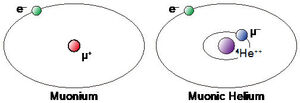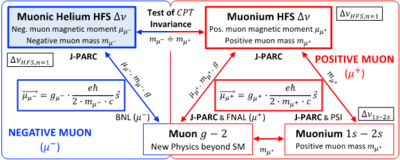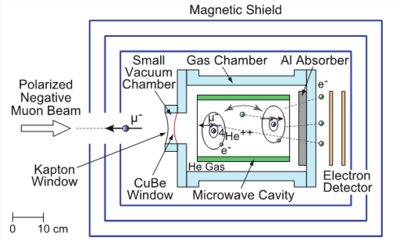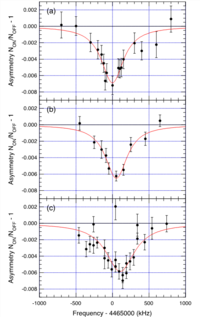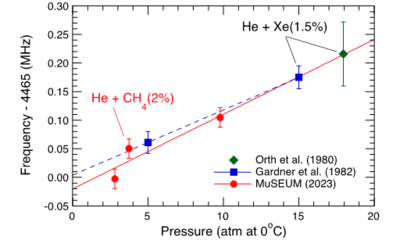Precision Spectroscopy Measurements of Muonic Helium Atoms- World record improved for the first time in 40 years -
High Energy Accelerator Research Organization (KEK)
J-PARC Center
Nagoya University
Nagoya University School of Science, The University of Tokyo
Story of this research
Question
∗ Muonic helium is composed of an ordinary helium atom with one of its two electrons replaced by a negative muon. Precision spectroscopy measurements of its energy structure can be used to determine the mass of the negative muon and verify the current theory of particle physics. However, this will require a hundredfold improvement over the accuracy of previous measurements.
Findings
∗ Muonic helium atom spectroscopy measurements at J-PARC MLF MUSE D-line were performed directly at zero magnetic field with a precision 3 times better than the previous measurement done in the 1980s. The result obtained is also more precise than the previous indirect measurement at high magnetic field improving the current world record precision by a factor of 1.5, establishing a highly precise spectroscopic method at J-PARC.
Meaning
∗ This is an important milestone for the coming measurements at the H-line planned at high magnetic field that will allow us to measure the energy structure of muonic helium atoms a hundred times more precisely and determine the negative muon mass with greater precision to test CPT invariance by comparing the masses of positive and negative muons (second-generation leptons).
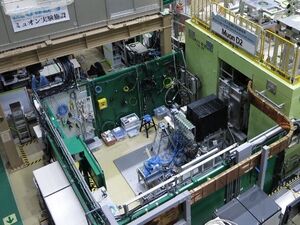 |
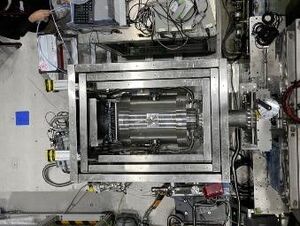 |
Figure 1: Experimental apparatus for muonic helium atom spectroscopy measurements in the D2 area of J-PARC MLF MUSE (left), and view of the experimental apparatus being assembled from above (right).
80 words summary
Precision spectroscopy measurements of the muonic helium atom energy structure were performed at J-PARC MLF MUSE D-line more precisely than previous measurements done 40 years ago, improving the current world record by a factor of 1.5. This is an important milestone for the coming measurements planned at the H-line with higher muon beam intensity and under a high magnetic field that will permit one to improve further the precision a hundred times and determine more precisely the negative muon mass.
Overview
A muonic helium atom, which is composed of an ordinary helium atom with one of its two electrons replaced by a negative muon※1, is a special atom that is not found in nature. It has a small energy level structure, called hyperfine structure※2, that results from the interaction between the remaining electron and the negative muon (due to the intrinsic properties of their respective spin).
※1 Muon
Precision spectroscopy measurements of the muonic helium atom hyperfine structure are the only available experimental results for three-body muonic atoms (i.e., helium nucleus, electron, and negative muon) that can be used to verify and improve the current theory of particle physics for three-body atomic system and quantum electrodynamics (QED), which accurately describes how matter and light interact at the quantum level. It can also be used to determine the mass of the negative muon to test CPT invariance by comparing the masses of positive and negative muons (second-generation leptons).
The hyperfine structure of muonic helium atoms has only been measured twice in the 1980s at the Paul Scherrer Institute in Switzerland (directly at zero magnetic field) and Los Alamos National Laboratory in the United States (indirectly at high magnetic field).
In this study, we succeeded in measuring the hyperfine structure of muonic helium atoms directly at zero magnetic field using the Muon Science Facility (MUSE) D-line at the Materials and Life Science Experimental Facility (MLF) of the Japan Proton Accelerator Research Complex (J-PARC※3) with a precision 3 times better than the previous direct measurement.
The result obtained is also 1.5 times more precise than the previous indirect measurement at high field improving the current world record and establishing a highly precise spectroscopic method. It was also performed for the first time with methane admixture used as an electron donor to form neutral muonic helium atoms efficiently, the prerequisite to measuring the hyperfine structure.
This technique will soon be used at the H-line, which offers about ten times higher muon beam intensity than at the D-line and the possibility of longer measurement time. This will allow us to measure the hyperfine structure of muonic helium atoms at high magnetic field a hundred times more precisely and determine the negative muon mass with greater precision.
A muon is an elementary particle with properties similar to the electron but with a mass about 200 times greater. Both positively and negatively charged muons exist. They can be found naturally in our surroundings, raining down to Earth from space as cosmic rays. However, muons decay in a very short time (about 2 microseconds lifetime). Negative muons can orbit nuclei the same way electrons do to produce a "muonic atom" with different characteristics from ordinary atoms because muons are much heavier.
※2 Hyperfine structure (HFS)
A small energy structure of an atom caused by the interaction between electrons and the nuclei. It is currently used in the cesium atomic clock to define the length of a second.
※3 J-PARC
J-PARC is a large-scale research facility jointly operated by the High Energy Accelerator Research Organization (KEK) and the Japan Atomic Energy Agency (JAEA) in Tokai-mura, Ibaraki Prefecture, Japan. J-PARC is a multi-purpose and multidisciplinary facility that is unique in the variety of secondary-particle beams produced and put to use in cutting-edge research across a wide range of scientific fields, from academic research in particle physics, nuclear physics, condensed matter physics, chemistry, materials science, and biology, to applied research in industrial fields.
Research Group
| Institute for Materials Structure Science (IMSS), High Energy Accelerator Research Organization (KEK) |
P. Strasser (lecturer), R. Iwai (research fellow), S. Kanda (assistant professor), S. Nishimura (special assistant professor), and K. Shimomura (professor). |
|---|---|
| Department of Physics, Nagoya University | S. Fukumura (graduate student), S. Kawamura (graduate student), M. Kitaguchi (associate professor), H. M. Shimizu (professor), and H. Tada (graduate student). |
| Graduate School of Science, The University of Tokyo | H. A. Torii (associate professor). |
| Graduate School of Arts and Sciences, The University of Tokyo | S. Seo (graduate student). |
A word from the researchers
There is nothing like good teamwork to achieve new scientific breakthroughs and reach exciting new frontiers.
Why did you start this research?
The hyperfine structure of muonic helium atoms can be precisely measured to determine the mass of negatively charged muons, one of the fundamental physical constants※4, and by comparing it with theoretical predictions, we can also verify the current theory of particle physics. However, there has been no precise measurement of the hyperfine structure of muonic helium atoms since their first measurements back in the 1980s.
In recent years, however, the MuSEUM※5 collaboration at J-PARC has developed a technique for measuring the hyperfine structure of muonium. Muonium and muonic helium are very similar (Fig. 2), both hydrogen-like atoms. They have almost equal hyperfine structures, but these are inverted because of the opposite charge of the muon. The same microwave magnetic resonance technique has the potential to measure the hyperfine structure of muonic helium atoms with a precision up to nearly 100 times greater than the current level. That is how this research was initiated.
※4 Fundamental physical constants
Physical quantities that express the fundamental properties of the natural world and are universal, and immutable throughout the Universe.
※5 MuSEUM Collaboration
Abbreviation for "Muonium Spectroscopy Experiment Using Microwave". An experiment to investigate the energy structure of a special type of atom called muonium, in which an electron orbits around a positively charged muon. Muonium does not exist in nature.
Figure 2: Comparison between a muonium atom (left) and a muonic helium atom (right).
Where did you get your inspiration?
We noted that precisely determining the mass of negatively charged muons using muonic helium atoms allows for testing the CPT theorem※6 by combining it with other experimental results on the mass of positively charged muons (antiparticles).
Additionally, the gas used in the experiment has distinctive characteristics. To form neutral muonic helium atoms, it is necessary to mix helium gas with a small amount of foreign gas that acts as an electron donor. Indeed, when the muon is captured by a helium atom, it quickly ejects both electrons and forms a singly charged muonic helium ion. Subsequently, it cannot capture an electron from neighboring helium atoms because its electron binding energy is much smaller, like hydrogen. In previous experiments performed in the 1980s, the noble gas xenon was used as an electron donor because it is easily ionizable. This time, we used methane (CH4) because it is more efficient, absorbs fewer muons than xenon, which has a higher atomic number, and is less expensive.
※6 CPT theorem
The CPT theorem says that the fundamental symmetry of physical laws under any combination of charge conjugation (C), parity inversion (P), and time reversal (T) holds for all physical phenomena. This means that any particle and its antiparticle must have the same mass, the same magnetic moment (with opposite sign), and the same lifetime.
Figure 3: Diagram showing the relationship between this research and other ongoing experiments at J-PARC and other research facilities.
Where did you put in the effort?
The precision of measuring the hyperfine structure of muonic helium atoms is mainly determined by the number of muonic helium atoms we can produce. On the other hand, muons captured by a helium atom decay in about 2 microseconds, so the precision of the measurement is essentially determined by the muon beam intensity and the measurement time. To improve the measurement precision as much as possible over a total beamtime of 15 days (carried out in three different cycles), we focused on optimizing the measurement conditions (Fig. 4) and studying different and more advanced analysis methods. We could measure the muonic helium hyperfine structure resonance curve with He + CH4 (2%) at three different pressures (Fig. 5) and extrapolate to zero pressure to determine the muonic helium atom hyperfine structure frequency (Fig. 6).
Figure 4: Schematic view of the experimental setup to measure the hyperfine structure of muonic helium atoms at zero magnetic field. (© 2023 American Physical Society)
Figure 5: Muonic helium hyperfine structure resonance curve measured at zero field with He + CH4 (2%) at (a) 3.0, (b) 4.0, and (c) 10.4 atm, respectively. The red solid lines represent the fitting results. (© 2023 American Physical Society)
Figure 6: Muonic helium atom hyperfine structure frequency as a function of the He + CH4 (2%) gas pressure (red circle). The red solid line shows the linear extrapolation to determine the hyperfine frequency at zero pressure. Previous results from Orth et al. (green diamond) and Gardner et al. (blue square) with the linear extrapolation (blue dashed line) measured with He + Xe(1.5%) are also shown for comparison.
What did you find out?
We succeeded in measuring the hyperfine structure of muon helium atoms with the world's highest precision and established the measurement technique using pulsed muons at J-PARC. The measurement results also show that the measurement precision can be improved by a factor of 100 using this technique and the high-intensity muon beams from MLF MUSE H-line at J-PARC. We are currently working on further technological developments to improve the measurement precision.
How would that change the world?
Compared to positively charged muons, negatively charged muons are measured less precisely in terms of mass, and the difference in properties due to the opposite charge has not yet been well studied. Suppose that more precise measurements of the hyperfine structure of muonic helium atoms are made based on this experiment. In this case, the difference in properties due to the charge, i.e., the difference between particles and antiparticles, could be clarified.
In addition, the theory of complex atoms composed of three or more particles is not well developed at present. Precise measurements of muonic helium atoms, which are composed of three particles (helium nucleus, electron, and muon), can be expected to provide a significant boost to verify and improve the current theory of particle physics.
Acknowledgments
 |
 |
The muon experiment at the Materials and Life Science Experimental Facility (MLF) of J-PARC was performed under a user program (Proposals No. 2020B0333, No. 2021B0169, No. 2022A0159). This work was supported by the JSPS KAKENHI Grant No. 21H04481.
Paper Information
"Improved Measurements of Muonic Helium Ground-State Hyperfine Structure at a Near-Zero Magnetic Field" , Physical Review Letters 131, 253003 (2023).

